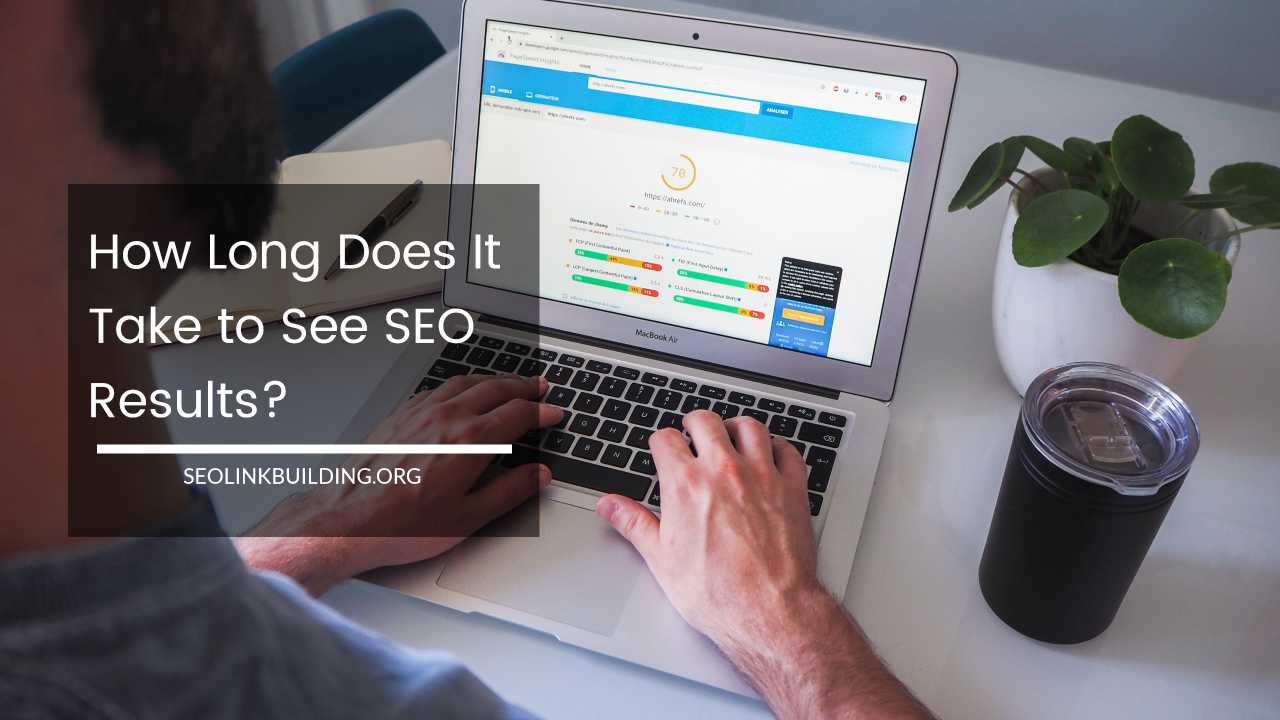How Long Does It Take to See SEO Results?

SEO Results
How Long Does It Take to See SEO Results?
The short answer is: it depends. SEO (Search Engine Optimization) is a multifaceted field with no guaranteed timeline for achieving results.
While a common benchmark suggests that you might start to see noticeable improvements in search engine rankings within three to six months, this timeframe is highly variable.
Several factors can significantly influence how quickly your SEO efforts yield results. These factors include the current state of your website, the competitiveness of your industry, the quality and consistency of your SEO practices, and the frequent changes in search engine algorithms.
Understanding the SEO Timeline
To gain a comprehensive understanding of how long SEO takes to produce results, it’s helpful to break down the process into its key components.
This breakdown provides insight into the stages involved and the typical timeframes associated with each stage.
1. Website Audit and Strategy
Timeframe: 1-2 Weeks
Process: The initial step in any successful SEO campaign is a comprehensive website audit. This audit involves assessing various aspects of your website, including its technical health, content quality, user experience, and overall structure. During this phase, SEO experts will:
- Evaluate Technical SEO: Identify issues such as broken links, crawl errors, and site speed problems.
- Assess Content Quality: Review existing content for relevance, keyword optimization, and engagement.
- Analyze User Experience: Examine factors like site navigation, mobile responsiveness, and overall usability.
Following the audit, a tailored SEO strategy is developed. This strategy is designed to address identified issues, capitalize on opportunities, and outline a roadmap for achieving SEO goals. The strategy typically includes keyword research, on-page and off-page SEO tactics, and a content plan.
2. On-Page Optimization
Timeframe: 2-4 Weeks
Process: On-page optimization involves making improvements to individual web pages to align them with SEO best practices. Key activities include:
- Keyword Optimization: Incorporating relevant keywords into page titles, meta descriptions, headers, and throughout the content. This helps search engines understand the topic of each page and improves its relevance to search queries.
- Content Enhancement: Updating or creating high-quality content that is valuable, informative, and engaging for your target audience. Content should be well-structured and include multimedia elements to enhance user experience.
- Website Structure Improvement: Enhancing site navigation, internal linking, and URL structure to make it easier for both users and search engines to find and access content.
The impact of on-page optimization can start to be visible within a few weeks, but it often takes time for search engines to index and rank the updated pages.
3. Off-Page Optimization
Timeframe: Ongoing
Process: Off-page SEO focuses on building your website’s authority and credibility through external efforts. Key components include:
- Backlink Building: Acquiring high-quality backlinks from reputable websites within your industry. Backlinks act as endorsements from other sites, signaling to search engines that your site is trustworthy and authoritative.
- Outreach and Networking: Engaging with influencers, bloggers, and industry leaders to build relationships and secure valuable backlinks.
- Social Media Engagement: Leveraging social media platforms to drive traffic, increase brand awareness, and generate engagement. Social signals can indirectly impact SEO by enhancing your site’s visibility and reach.
Off-page optimization is an ongoing process, and its effects on rankings can accumulate gradually. Building a strong backlink profile and establishing your site’s authority takes time and consistent effort.
4. Content Creation and Optimization
Timeframe: Ongoing
Process: Content creation and optimization are continuous activities that play a crucial role in SEO. This involves:
- Producing High-Quality Content: Creating content that addresses your audience’s needs, interests, and pain points. High-quality content should be well-researched, original, and provide real value to readers.
- Optimizing Content for SEO: Ensuring that content is optimized for relevant keywords and structured to enhance readability. This includes using headings, bullet points, and multimedia elements to improve user engagement and comprehension.
- Content Updates: Regularly updating existing content to keep it relevant and accurate. Fresh content signals to search engines that your site is active and up-to-date.
Consistent content creation and optimization help maintain and improve your site’s relevance and authority, contributing to better rankings over time.
5. Technical SEO
Timeframe: Ongoing
Process: Technical SEO ensures that your website is technically sound and accessible to search engines. Key aspects include:
- Site Speed Optimization: Improving loading times by compressing images, leveraging browser caching, and minimizing HTTP requests. Faster sites provide a better user experience and are favored by search engines.
- Mobile-Friendliness: Ensuring that your site is fully responsive and performs well on mobile devices. With the increasing use of mobile devices, mobile optimization is crucial for SEO success.
- XML Sitemaps and Robots.txt: Creating and submitting XML sitemaps to help search engines crawl and index your site efficiently. Managing the robots.txt file to control which pages search engines should or should not crawl.
Technical SEO improvements can lead to gradual enhancements in search engine rankings and overall site performance. Regular maintenance and updates are essential to keep your site in optimal condition.
6. Monitoring and Analysis
Timeframe: Ongoing
Process: Continuous monitoring and analysis are vital for assessing the effectiveness of your SEO efforts. This involves:
- Tracking Key Metrics: Using tools like Google Analytics and Search Console to monitor organic traffic, keyword rankings, and user behavior. Key metrics include traffic sources, bounce rates, and conversion rates.
- Data Analysis: Analyzing performance data to identify trends, measure progress, and understand what’s working or needs adjustment. This includes evaluating the effectiveness of your content, backlinks, and technical improvements.
- Strategy Refinement: Making data-driven adjustments to your SEO strategy based on performance insights. Regularly reviewing and refining your approach helps optimize results and adapt to changes in search engine algorithms and industry trends.
Factors Affecting SEO Timeline
Several factors can influence how quickly you see results from your SEO efforts. Understanding these factors can help set realistic expectations and guide your strategy.
Website Age and Authority
Older, Established Websites: Websites with a long history and established authority often have a head start in terms of rankings. They may see improvements more quickly if they are well-maintained and follow SEO best practices. An established site’s existing backlinks and historical performance can provide a competitive edge.
New Websites: Newer websites face challenges in gaining traction. Building authority and trust takes time, and new sites may need to invest more effort in creating high-quality content and acquiring backlinks to achieve significant results. It’s important for new sites to focus on foundational SEO practices and be patient as they build their presence.
Keyword Difficulty
High-Difficulty Keywords: Targeting highly competitive keywords—those with many established competitors and substantial search volumes—can be challenging and may take longer to rank for. Success in these areas often requires extensive effort, including high-quality content, robust backlink strategies, and ongoing optimization.
Low-Difficulty Keywords: Keywords with less competition, often referred to as long-tail keywords or niche topics, may offer quicker results. Targeting these keywords can be a strategic approach for new or smaller websites looking to build their authority and gain visibility.
Content Quality and Quantity
High-Quality Content: Content that is well-researched, engaging, and provides real value to users is more likely to perform well in search engine rankings. Quality content helps build credibility and attract backlinks, which contribute to faster SEO improvements.
Content Quantity: Regularly updating your site with fresh content can positively impact SEO. Consistent content creation signals to search engines that your site is active and relevant. However, the focus should always be on quality over quantity; content that is informative and valuable will have a more significant impact.
Backlink Profile
Strong Backlink Profile: A robust backlink profile with links from reputable and relevant sites can significantly boost your rankings. Building a diverse range of high-quality backlinks enhances your site’s authority and credibility.
Weak Backlink Profile: A lack of backlinks or a profile with low-quality or spammy links can hinder your progress. Investing in ethical and strategic backlink-building efforts is crucial for enhancing authority and achieving faster SEO results.
User Experience
Positive User Experience: Factors such as fast loading times, mobile responsiveness, and intuitive navigation play a significant role in SEO. A positive user experience not only improves rankings but also enhances user satisfaction and engagement.
Negative User Experience: Issues such as slow site speed, poor mobile usability, and confusing navigation can negatively impact your rankings and user engagement. Addressing these issues promptly is essential for maintaining a positive user experience.
Search Engine Algorithm Updates
Algorithm Changes: Search engines frequently update their algorithms to improve search results and user experience. These updates can impact rankings and timelines. Staying informed about algorithm changes and adjusting your SEO strategies accordingly can help mitigate any negative effects.
Adaptation and Flexibility: Being adaptable and responsive to changes in search engine algorithms is crucial for long-term SEO success. Regularly reviewing and updating your SEO practices ensures that your site remains aligned with current best practices and trends.
Accelerating SEO Results
While there is no guaranteed way to speed up SEO results, several strategies can improve your chances of achieving faster and more significant improvements:
Prioritize High-Quality Content
Create Valuable Content: Focus on producing content that addresses your target audience’s needs, interests, and pain points. High-quality content should be well-researched, original, and provide real value to readers. Engaging content is more likely to attract backlinks and shares, contributing to better rankings.
Optimize Content: Ensure that your content is optimized for relevant keywords and structured to enhance readability. This includes using headings, bullet points, and multimedia elements to improve user engagement and comprehension. Well-optimized content is more likely to rank well and attract organic traffic.
Build High-Quality Backlinks
Acquire Reputable Backlinks: Aim to obtain backlinks from authoritative websites within your industry. High-quality backlinks act as endorsements from other sites, signaling to search engines that your site is trustworthy and credible.
Focus on Relevance: Seek backlinks from sites that are relevant to your niche or industry. Relevant backlinks carry more weight and contribute to better rankings. Building relationships with industry influencers and participating in guest blogging can help acquire valuable backlinks.
Optimize for Mobile
Mobile-Friendly Design: Ensure that your website is fully responsive and performs well on mobile devices. With the increasing use of smartphones and tablets, mobile optimization is crucial for SEO success. A mobile-friendly design improves user experience and can positively impact search engine rankings.
Test Mobile Performance: Regularly test your site’s mobile performance and make necessary adjustments to ensure a seamless user experience across all devices. Tools like Google’s Mobile-Friendly Test can help identify and address any mobile usability issues.
Improve Website Speed
Optimize Loading Times: Implement techniques to reduce loading times, such as compressing images, leveraging browser caching, and minimizing HTTP requests. A faster site enhances user experience and can positively impact search engine rankings.
Monitor Performance: Use tools like Google PageSpeed Insights or GTmetrix to assess and improve your site’s speed performance. Regularly monitoring and optimizing site speed helps maintain a positive user experience and supports SEO efforts.
Monitor and Analyze Your Results
Track Key Metrics: Regularly monitor key SEO metrics, such as organic traffic, keyword rankings, and conversion rates. Analyzing this data helps you understand the effectiveness of your SEO efforts and identify areas for improvement.
Make Data-Driven Adjustments: Use insights from your analytics to refine your SEO strategy. Adjustments based on performance data can enhance your results and ensure that your efforts are aligned with your goals. Continuously reviewing and updating your strategy helps optimize SEO performance.
Be Patient
Understand SEO is a Long-Term Investment: SEO is not a quick fix but a long-term strategy. Achieving substantial results may take several months, so it’s important to stay patient and persistent. SEO efforts build over time and require consistent dedication.
Celebrate Small Wins: Acknowledge and celebrate incremental successes along the way. Small improvements can build momentum and lead to more significant results over time. Recognizing progress helps maintain motivation and focus on long-term goals.
Final Thoughts
SEO is a multifaceted and ongoing process that requires time, effort, and strategic planning. While it’s challenging to pinpoint an exact timeline for seeing results, understanding the key factors and stages involved can help set realistic expectations.
By focusing on high-quality content, building a strong backlink profile, optimizing for mobile and speed, and continuously monitoring your performance, you can improve your chances of achieving faster and more impactful SEO results.
Remember, SEO is a marathon, not a sprint. It involves consistent effort, adaptation to best practices, and a commitment to staying informed about industry trends and algorithm updates.
By following these guidelines and maintaining patience, you can enhance your website’s visibility, attract more organic traffic, and achieve long-term success in search engine rankings.













